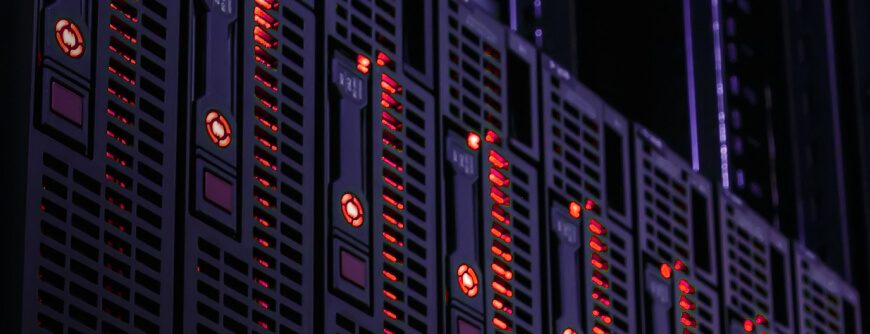클라우드 데이터센터와 같은 고속, 대용량 환경에서는 관리자가 하드웨어에 맞출 수 있는 공간이 한정돼 있습니다. 블레이드 서버는 섀시에 들어갈 수 있는 컴팩트한 물리적 시스템을 제공하여 수천 대 서버를 호스팅하는 데 필요한 공간을 최소화합니다. 섀시는 여러 블레이드 서버를 수용하며 랙에 설치됩니다. 컴팩트 서버는 함께 작동하여 엔터프라이즈용 고성능 컴퓨팅 서비스를 제공합니다.
블레이드 서버란?
데이터센터 환경에서 관리자는 가능한 한 많은 서버를 수용해야 합니다. "블레이드"라는 용어는 "베이(bay)"에 장착돼 서로 연결하여 고성능 컴퓨팅을 수행하는 매우 얇고 작은 서버를 지칭합니다. 베이는 최대 8개의 블레이드를 장착할 수 있는 박스형 컨테이너(섀시)에 들어 있습니다. 섀시는 데이터센터에 위치한 랙에 설치됩니다. 이 구성을 통해 하나의 랙에 수십 대 서버를 장착할 수 있습니다.
블레이드는 개별 서버이므로 CPU, 메모리, 네트워크 컨트롤러, 입력 및 출력 포트 등 시스템을 구성하는 기본 하드웨어 구성 요소를 포함합니다. 여러 개의 블레이드를 광섬유로 연결하여 서버와 네트워크 간 데이터를 빠르게 공유할 수 있습니다.
블레이드 서버의 구성 요소는 무엇인가요?
블레이드 서버에 포함된 하드웨어는 제조업체에 따라 다르지만 대부분의 시스템에는 일반적인 기본 구성 요소가 포함돼 있습니다. 이 서버는 너무 많은 공간을 차지하는 대형 개별 서버 없이도 작동하는 기본 기능을 갖추고 있습니다. 컴팩트 머신에는 CPU, 메모리, 머신의 온도를 낮춰주는 구성 요소(예: 방열판)가 포함돼 있습니다.
핫스왑이 가능한 드라이브는 많은 블레이드 서버에 설치할 수 있지만, NAS(네트워크 연결 스토리지) 또는 SAN(스토리지 영역 네트워크)을 이용해 블레이드 서버에서 사용할 파일을 호스팅할 수도 있습니다. 또한 네트워크 컨트롤러와 로컬 네트워크에 연결할 수 있는 인터페이스도 포함되어 있습니다.
블레이드는 여러 블레이드 서버를 함께 고정하는 외부 부품인 섀시에 연결됩니다. 섀시는 랙 인클로저에 연결됩니다. 랙에 장착할 수 있는 섀시 수는 랙의 크기와 각 섀시 크기에 따라 다릅니다. 일반적으로 랙에는 블레이드 서버에 연결되는 케이블용 공간도 있어야 합니다.
블레이드 서버는 어떻게 작동하나요?
기존의 단일 서버 환경에서는 비즈니스에 컴퓨팅 서비스를 관리하는 서버가 한 대 있습니다. 클라우드에서는 관리자가 하드웨어를 로컬에서 호스팅하는 비용없이 여러 대의 서버를 활용할 수 있습니다. 블레이드 서버는 개별 서버이지만 여러 블레이드 서버가 함께 작동해 컴퓨팅 성능을 결합함으로써 사용자 애플리케이션 실행 등의 기능을 수행합니다. 각 블레이드 서버는 애플리케이션을 담당하지만 서버는 네트워크를 통해 데이터를 공유할 수 있습니다.
랙 서버 대비 블레이드 서버의 장점 중 하나는 블레이드 서버가 더 컴팩트하여 단일 섀시 및 서버 랙에 더 많은 서버를 장착할 수 있다는 점입니다. 블레이드 서버는 효과적인 작동을 위해 최소한의 구성 요소만 포함하지만, 제거해야 하는 열을 발생 시킵니다.
모든 블레이드에는 단일 서버가 포함되지만 단일 랙 내에 여러 개의 블레이드가 포함될 수 있습니다. 블레이드 서버를 임대하는 기업은 일반적으로 중요한 애플리케이션을 지원하기 위해 한 번에 여러 대를 임대하지만, 이러한 서버는 모듈화되어 있습니다. 클러스터 내 모든 블레이드 서버의 전원을 끄지 않고도 핫스왑 기능을 사용해 데이터센터 간에 블레이드 서버를 이동할 수 있습니다.
블레이드 서버를 사용해야하는 이유
여러 대의 서버가 필요하지만 이를 수용할 공간이 없는 경우, 블레이드 서버를 사용하는 것이 좋습니다. 각 블레이드는 단일 서버이며, 이러한 블레이드는 좁은 공간에 적합합니다. 클라우드 서비스를 사용하면 물리적 사무실 공간에 블레이드 서버를 설치하지 않고도 임대할 수 있습니다. 그러나 데이터센터 관리자는 블레이드 서버를 여전히 온프레미스에 설치해야 합니다.
블레이드 서버는 가장 컴팩트한 컴퓨팅 성능으로서, 일반적으로 수천 명의 사용자를 위해 빠른 속도를 요하는 주요 애플리케이션을 지원하는 엔터프라이즈 컴퓨팅 성능의 일부입니다. 블레이드 서버를 이동하기로 결정한 경우, 핫스왑이 가능하므로 관리자가 서버를 이동하기 위해 전체 시스템 전원을 끌 필요가 없습니다. 블레이드 서버의 주요 이점은 다음과 같습니다:
- 모듈형 및 핫스왑 가능
- 고속 컴퓨팅 성능 제공
- 스트리밍, 웹 캐싱, 가상화 등 인기 웹 서비스 지원
- 로드 밸런싱 및 페일오버로 클러스터된 서비스 제공
블레이드 서버를 사용하지 않는 이유
소규모 비즈니스를 운영하며 온프레미스에서 서비스를 호스팅하는 경우, 표준 독립형 서버보다 비용이 많이 드는 블레이드 서버를 선택하지 않을 수 있습니다. 조직이 간단한 온프레미스 또는 클라우드 서비스로 운영되는 경우, 블레이드 서버가 필요하지 않을 수 있습니다.
클라우드 서비스를 사용하면 블레이드 서버와 관련된 유지보수에 대해 걱정할 필요가 없습니다. 블레이드 서버를 포함한 모든 컴퓨팅 장비를 보관할 때는 열과 습도 관리가 중요합니다. 컴퓨터 장비를 보관하려면 서버 환경을 적절하게 유지하기 위해 적절한 온도 및 습도 제어가 필요합니다. 이것이 어렵다면 블레이드 서버를 로컬에 설치하지 말아야 합니다.
결론
블레이드 서버는 가상화를 지원하므로 클라우드 환경에서도 사용할 수 있습니다. 클라우드 제공업체가 제공하는 서버 유형은 활용하는 서비스에 따라 다르기 때문에, 이미 클라우드에서 블레이드 서버를 사용하고 있을 수도 있습니다. 특히 빠르고 컴팩트한 서버가 필요한 경우, 블레이드 서버를 사용해 빠른 애플리케이션을 제공하고 수천 명의 사용자를 지원할 수 있습니다.



